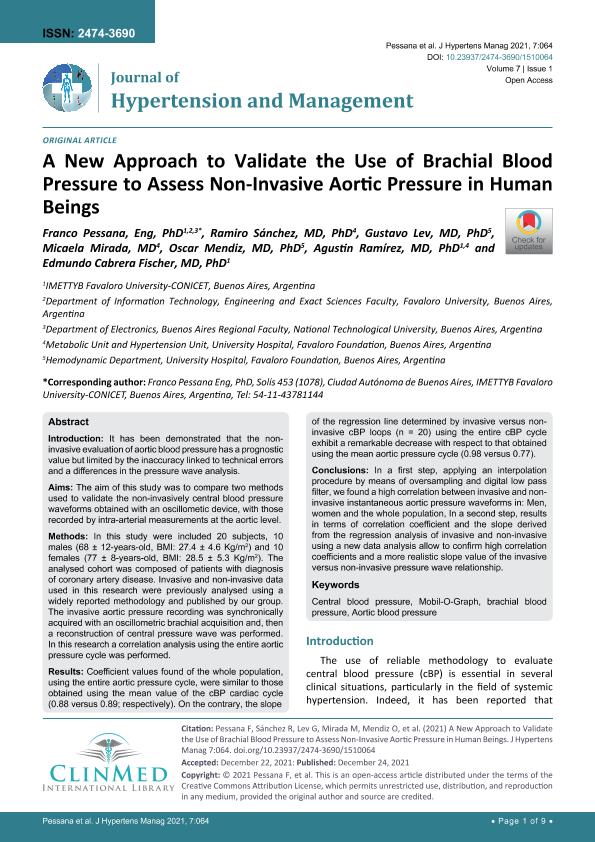Artículo
A New Approach to Validate the Use of Brachial Blood Pressure to Assess Non-Invasive Aortic Pressure in Human Beings
Pessana, Franco Martin; Sanchez, Ramiro; Lev, Gustavo; Mirada, Micaela; Mendiz, Oscar; Ramírez, Agustín José ; Cabrera Fischer, Edmundo Ignacio
; Cabrera Fischer, Edmundo Ignacio
 ; Cabrera Fischer, Edmundo Ignacio
; Cabrera Fischer, Edmundo Ignacio
Fecha de publicación:
06/2021
Editorial:
ClinMed International Library
Revista:
Journal of Hypertension and Management
ISSN:
2474-3690
Idioma:
Inglés
Tipo de recurso:
Artículo publicado
Clasificación temática:
Resumen
Introduction: It has been demonstrated that the noninvasive evaluation of aortic blood pressure has a prognostic value but limited by the inaccuracy linked to technical errors and a differences in the pressure wave analysis.Aims: The aim of this study was to compare two methods used to validate the non-invasively central blood pressure waveforms obtained with an oscillometic device, with those recorded by intra-arterial measurements at the aortic level.Methods: In this study were included 20 subjects, 10 males (68 ± 12-years-old, BMI: 27.4 ± 4.6 Kg/m2) and 10 females (77 ± 8-years-old, BMI: 28.5 ± 5.3 Kg/m2). The analysed cohort was composed of patients with diagnosis of coronary artery disease. Invasive and non-invasive dataused in this research were previously analysed using a widely reported methodology and published by our group.The invasive aortic pressure recording was synchronically acquired with an oscillometric brachial acquisition and, then a reconstruction of central pressure wave was performed.In this research a correlation analysis using the entire aortic pressure cycle was performed.Results: Coefficient values found of the whole population, using the entire aortic pressure cycle, were similar to those obtained using the mean value of the cBP cardiac cycle was analysed (0.88 versus 0.89; respectively). On the contrary, the slope of the regression line determined by invasiveversus non-invasive cBP loops (n = 20) using the entire cBP cycle exhibit a remarkable decrease with respect to that obtained using the mean aortic pressure cycle (0.98 versus 0.77).Conclusions: In a first step, applying an interpolation procedure by means of oversampling and digital low pass filter, we found a high correlation between invasive and noninvasive instantaneous aortic pressure waveforms in: Men, women and the whole population, In a second step, resultsin terms of correlation coefficient and the slope derived from the regression analysis of invasive and non-invasive using a new data analysis allow to confirm high correlation coefficients and a more realistic slope value of the invasive versus non-invasive pressure wave relationship.
Archivos asociados
Licencia
Identificadores
Colecciones
Articulos (IMETTYB)
Articulos de INSTITUTO DE MEDICINA TRASLACIONAL, TRASPLANTE Y BIOINGENIERIA
Articulos de INSTITUTO DE MEDICINA TRASLACIONAL, TRASPLANTE Y BIOINGENIERIA
Citación
Pessana, Franco Martin; Sanchez, Ramiro; Lev, Gustavo; Mirada, Micaela; Mendiz, Oscar; et al.; A New Approach to Validate the Use of Brachial Blood Pressure to Assess Non-Invasive Aortic Pressure in Human Beings; ClinMed International Library; Journal of Hypertension and Management; 7; 1; 6-2021; 1-9
Compartir
Altmétricas
Items relacionados
Mostrando titulos relacionados por título, autor y tema.
-
Menossi, Matias ; Milanesio, Juan Manuel ; Ciolino, Andrés Eduardo ; Deneulin, Severine; Zabaloy, Marcelo Santiago (Elsevier Science, 2020-05)
-
Tironi, Valeria Anahi ; De Lamballerie, Marie; Le Bail, Alain (Elsevier, 2010-10)



